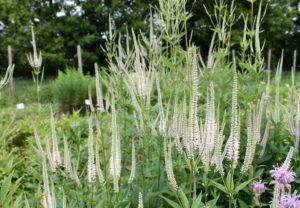Culver’s root (Veronicastrum)
* Common name: Culver’s root 
* Botanical name: Veronicastrum virginicum
* What it is: Culver’s root is a Pennsylvania-native perennial that’s recognizable by its very tall and slender white flower spikes that bloom from late June and throughout July into early August.
It’s a pollinator favorite that grows best in full sun to part shade with evenly damp soil. In nature, it’s usually found growing in open woods and damp meadows.
* Size: Including those tall flower spikes, plants grow four to five feet tall. Space plants two to two-and-a-half feet apart.
* Where to use: Culver’s root is a good choice for any damp spot that gets at least half-day sun. A rain garden is a natural, but the flower spikes look nice in any cottage garden, pollinator garden, or perennial border.
* Care: Adequate water is the main care issue. A naturally damp site solves that, but pay attention to add water if the weather turns hot and dry.
A scattering of a balanced, organic granular fertilizer early each spring (or a topping of compost) is helpful but usually not necessary.
Cut back flower spikes after bloom to neaten the plant. Then cut the whole plant to the ground after frost browns the foliage in fall or at the end of winter.
You’ll likely need to stake these tall plants to keep them from flopping, unless the site is getting plenty of sun and/or neighboring plants are holding up the Culver’s root plants.
Dig and divide sections in early spring to expand widening clusters.
* Great partners: Monarda (bee balm), mountain mint, swamp milkweed, cardinal flower, liatris, Joe Pye weed, and hardy hibiscus are other perennials if you’re trying to plant a native pollinator garden in a damp and bright spot. Fothergilla, Virginia sweetspire, smooth hydrangea, buttonbush, and summersweet are good native shrub choices that prefer similar conditions.







